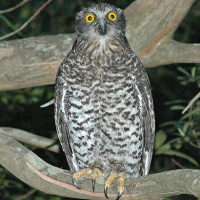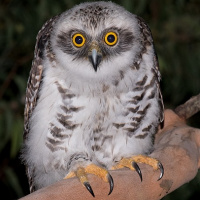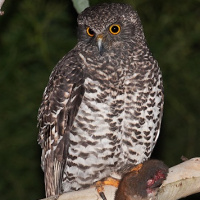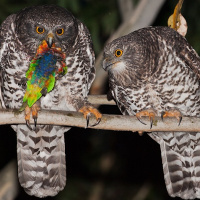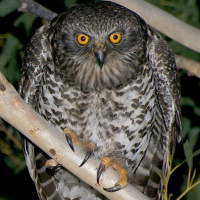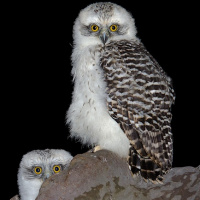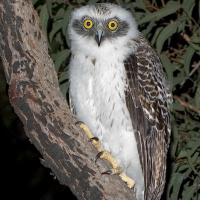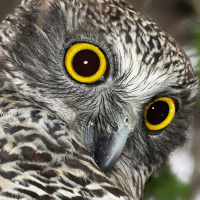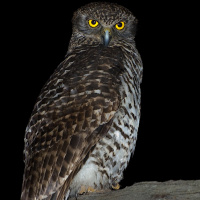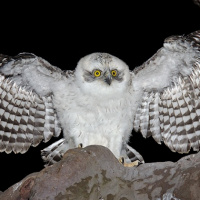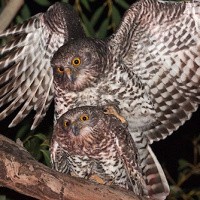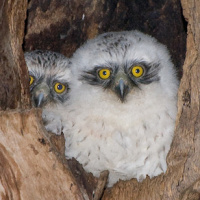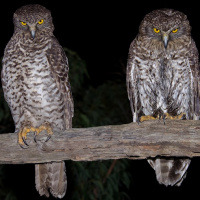Introduction
The Powerful Owl is a large owl with a rounded head and no ear-tufts. It is the largest owl in Australia.
Photo Gallery (15 pictures)
Sound Gallery
Information
Description: The facial disc is dark brown, and surrounds bright yellow eyes with prominent eyebrows and a powerful, bluish-horn bill with
bristly feathers at its base. Males have a broader head and flatter crown.
The colour of the upperparts varies from grey-brown to dark brown and may appear bluish in dull light. The forehead is creamy white and the crown and
nape finely spotted creamy white. The back and wings are irregularly barred, also in creamy white. There are approximately six narrow creamy white bars across
the tail.
Underparts are dull white with broad brown chevrons from throat to vent, arranged in irregular bars. The tail is broadly barred brown and white. Tarsi are
feathered to the base of the toes, which are sparcely bristled and dull yellow. Claws are dusky horn with blackish tips.
Size: Length 45-65cm. Wing length 381-427mm. Tail length about 280mm. Weight 1050-1700g. Males are larger and heavier than females.
Habits: Lives permanently in pairs. Nocturnal. Roosts by day singly, in pairs or in family groups of 3-4, in foliage or open tree in forest or woodland. They will often roost with the remains of prey clutched in their talons. May be easily approached during the day, but is shy and difficult to observe at night. Flight is slow and deliberate. May be very aggressive in defending the nest. If the female is disturbed during incubation, she will often desert the nest.
Voice: The Powerful Owl's voice is a slowly uttered, rather mournful, loud, two-syllable note that sounds like "woo-hoo", each note lasting just over half a second with a brief pause in between. The second note is often slightly higher pitched than the first, more so in the female than in the male. The male's voice is slightly deeper than female's. There are also various other calls associated with breeding and nesting, including a strange, tremulous, sheep-like bleating uttered be either sex around the nest. This may show anger (when it becomes almost a snarl), anxiety or be used by the female when the male is returning with food.
Hunting & Food: The Powerful Owl hunts from perches, mainly on slow-moving arboreal mammals and large birds which are caught at their roosts. They will occasionally take insects and prey on the ground. Birds may be roughly plucked before eating but never as thoroughly as with diurnal birds of prey. Large prey is often not eaten until the night after capture and Owl roosts with one foot on prey which is draped over branch. The reason for this not known but this also occurs commonly with Rufous Owls and occasionally with Barking Owl.
Breeding: Breeds during winter, with each female typically laying on
almost the same date each year. Most eggs are laid from the second week in May to the
third week June. Males begin calling in late February or early March. Around this time,
pairs begin to roost closer together, at first in same tree and then on same branch, often
still some distance from the potential nest site. The nest is a large hollow, nearly
always in the trunk or broken off top of a big eucalypt. In tall forest this is usually at
the head of a gully or on a hillside at heights from 20-45 metres. Where
tall trees are not available, the nest may be in open forest or among part-cleared timber
at levels as low as 6 metres. Usually 2 eggs, rarely 1, are laid at 4 day
intervals. They are almost spherical and are dull white, measuring 49-56mm x 43-46mm. Incubation is about 38 days with the male rarely visiting the
nest after laying - the female leaves the hollow to take food from him. The young have
first and second downs of white, becoming stained in the nest. The Beak and feet seem
disproportionately huge in early weeks. They are brooded constantly by the female until
about 4 weeks when she abruptly ceases to brood by day and her visits become progressively
shorter at night. First flight is at 7 to 8 weeks while still partially downy. After
fledging, the young remain with their parents for weeks or months, roosting near or with
one of them, sometimes remaining with parents in late autumn and this may inhibit them
from breeding in the following season.
Females are shy and may desert a nest after minimal human disturbance, particularly early in the season. Some males, however, may be
extremely aggressive in the breeding season, attacking humans with great ferocity even at
a considerable distance from the nest. This is most likely when there are young in the
nest but may occur even before laying and occasionally when juveniles are roosting nearby.
Habitat: Typically wet and hilly sclerophyll forest with dense gullies adjacent to more open forest. Will also occur in smaller, drier forest, provided that there are some large tree hollows and an adequate supply of prey.
Distribution: South-eastern Australia. Generally confined to the forests of the Great Dividing Range and through to the coast.

Range of the Powerful Owl Ninox strenua
Status: Uncommon. Listed as 'Least Concern' by Birdlife International.
Original Description: Gould, John. 1838. A synopsis of the birds of Australia, and the adjacent islands (Syn. Birds Austr.): Pt. 3, pl. 47, fig. 2.

